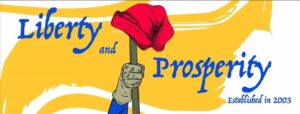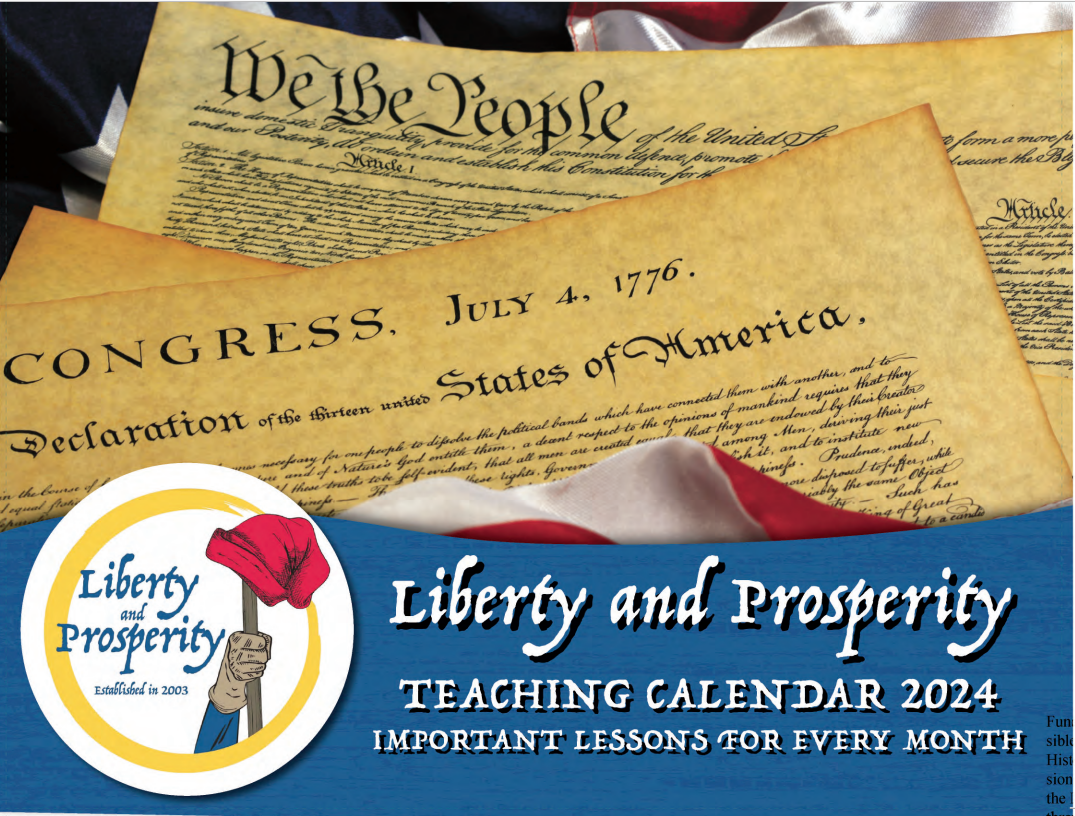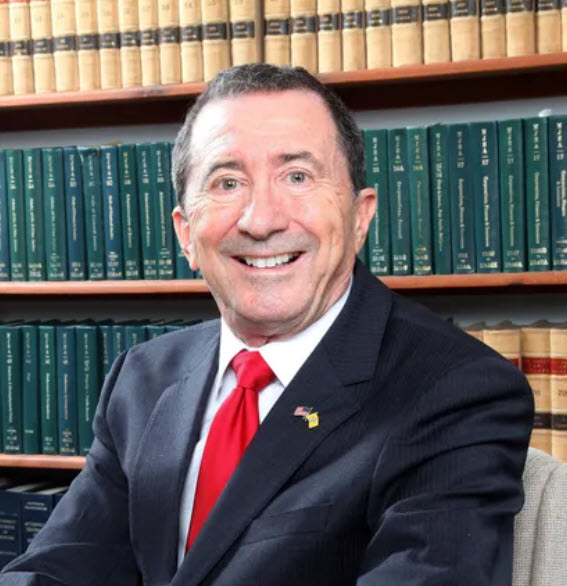Several years ago, I taught U.S. History as an adjunct history professor at a local community college. The textbook I was required to use had two serious flaws. First, every chapter delivered at least one “woke” political message. Occasionally this was done by reciting false information. However, it was usually done by leaving out important and relevant true information.
Also, as a standardized national textbook, it did not mention important local historical events or personalities, or how they related to the national narrative.
Last year, Liberty and Prosperity published and distributed a “Teaching Calendar” to provide some of this missing history. It was very well received. This year, I would like to take a step further. I would like to publish a complete history booklet that can be used by history teachers and professors to supplement important historical information that is missing from their textbooks.
I would like to begin this process by telling 28 stories of important historical events in New Jersey from 18,000 BC to 1844. If this project is successful, I would like to publish a second volume telling stories from 1845 to the present.
I invite you to take the time to read each of the following 28 stories. If you have doubts about the accuracy of any of them, I invite you to contact me and share your information. If you are aware of other stories that should also be included, please let me know of them. If you know of any sources that support or oppose any facts in any of these stories, please let me know so we can fully document this work or do further research.
Please inform us of any errors in grammar, spelling or punctuation.
Finally, we would like to publish several images for each story. However, we do not have the resources to pay for illustrations. The images shown below are from quick internet searches. They are only posted as examples and may not be suitable for publication. If you have access to any appropriate image with permission to publish, or which is in the public domain, please send it to us. Thank you for your assistance with this most important project.
Seth Grossman
Somers Point, NJ
April 2, 2025
- ICE AGE AND LANDBRIDGE. MIGRANTS FROM ASIA SETTLE IN NORTH AMERICA.

About 20,000 years ago, there was global cooling. In northern North America, Europe, and Asia (and in southern South America), snow that fell during the winter did not melt in the summer. For thousands of years, that snow piled up, compressed, and covered those areas with thick sheets of ice. The ice over what is now Chicago was roughly 3,000 feet thick. All of New Jersey north of what is now New Brunswick was covered with ice.
During that Ice Age, sea levels were 400 feet below what they are today. What is now Atlantic City was 30 to 50 miles away from the ocean. Dry land connected eastern Asia and western North America.
Nomadic tribes from what is now China and Mongolia walked across that landbridge and settled in North America. Their descendants were later known as American Indians or Native Americans.
146 Words
Mapped: What Did the World Look Like in the Last Ice Age? – Full Size
Thickness of the Ice Sheets of Last Glaciation Compared to Modern Skylines
2. EARTH WARMS, ICE SHEETS MELT, LENNI-LENAPE REACH THE DELAWARE RIVER.

About 13,000 years ago, the world’s climate changed again. The earth got warmer. The giant ice sheets melted. They left thousands of lakes throughout Canada and the northern United States. Among them were Lake Hopatcong in New Jersey and the Great Lakes. Sea levels rose to their current levels.
During this time, groups of American Indians moved into those areas. Tribes speaking an “Algonkian” language moved to the north and east. They included the Powhatan in Virginia, the Mohegan (Mohicans) in Connecticut, the Shawnee in Ohio, and the Algonquian of Quebec and Ontario in Canada.
The Algonkians who settled in and around Eastern Pennsylvania called themselves the Lenni-Lenape. That means “real people”. According to their legends, all the Algonkian nations branched out from their tribe.
This may explain why other tribes often asked the Lenni-Lenape to mediate and settle disputes.
Many Lenni-Lenape were later called the Delaware. That is because they lived near the Delaware River and Bay. The English named these bodies of water after Lord De La Warr. He was their Governor and Captain General of Virginia in 1610.
183 words
3. THE LENNI-LENAPE SPEND SUMMERS BY THE CREEKS AND BACK BAYS OF SOUTH JERSEY.
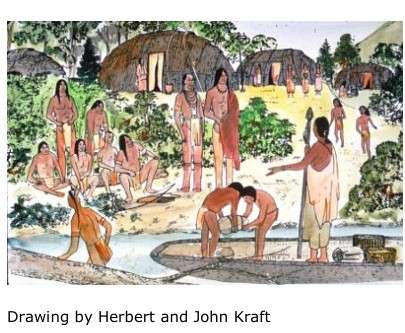
EARLY-IMAGES-OF-LENAPE-PEOPLE-2.pdf
Many Lenni-Lenape who lived near the Delaware River left their villages after planting their spring crops. They set up summer homes near the creeks and back bays of South Jersey. There they hunted, fished, and gathered clams and oysters. They called one back bay “Absegami”, which means “Little Water”. Today it is called Absecon Bay. A nearby town in Atlantic County is now known as Absecon. The island on the other side of that bay where Atlantic City is located is Absecon Island.
At the end of each summer, the Lenni-Lenapi returned to their villages across the Delaware River. There they harvested their crops and spent their winters.
108 words
Lenni-Lenape | Atlantic County, NJ
4. WHILE ITALIAN MERCHANTS TRADE WITH CHINA. OTTOMAN TURKS BUILD AN EMPIRE.
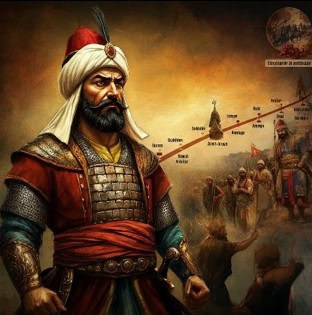
In the year 1281, a Turkish warrior chief named Osman took control of Bursa. It was a small, little-known kingdom near what is now the city of Istanbul in Turkey. Bursa was more than 5,000 miles away from the lands of the Lenni-Lenape in America. However, what happened in Bursa started a chain of events that later brought Europeans to where the Lenni -Lenape spent their summers.
In 1281, Istanbul was known as Constantinople. It was the largest city in Europe. It was a center of world commerce. It had been the center of Greek and Christian culture for nearly a thousand years.
Ships from the Mediterranean Sea passed by Constantinople on their way to busy port cities on the Black Sea. From there, caravans took their goods to China. Those goods included wheat, honey, olive oil, leather, wine, knives and swords. Those ships and caravans brought silk, tea, ceramics and spices back from China to Europe.
Italian merchants from Venice, Genoa, Florence and Milan owned and sailed most of those ships. Marco Polo was one of them. He wrote a famous book about his travels.
Osman and his successors ended that.
193 words
5. OTTOMAN TURKS PUSH ITALY’S SEA CAPTAINS INTO THE ATLANTIC OCEAN.
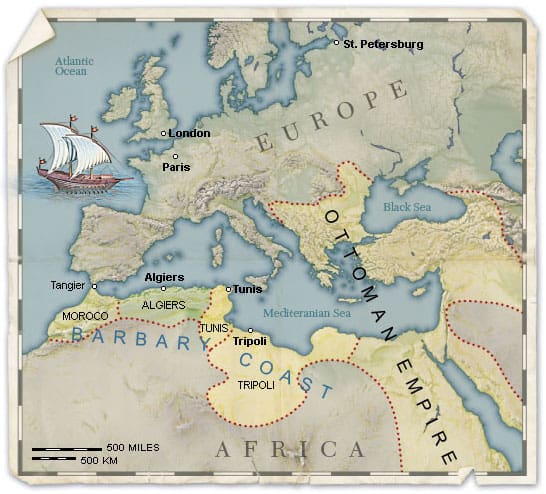
At first, Osman was known as a “ghazi”. That is an Arabic word. It describes a Muslim raider who attacks and robs the towns and caravans of nonbelievers during jihads (religious wars). However, Osman and his successors soon did what ghazis rarely did before. They held and occupied the cities and towns they attacked. They quickly turned their small kingdom of Bursa into a powerful Empire. They recruited, organized and equipped large professional armies and navies. They ruled and taxed the people they conquered with ruthless efficiency.
Osman’s name was also pronounced “Ottoman”. The empire that Osman and his descendants created became known as The Ottoman Empire.
By the late 1300s, the Ottomans had conquered most of present-day Turkey, Greece and Southeastern Europe. They also seized most of the islands and port cities used by Italian merchant ships. In 1453, the Ottomans seized Constantinople.
The Ottomans and their “Barbary” allies in North Africa made most of the Mediterranean Sea dangerous and unprofitable for Italian merchants and their ships. The Italians looked for new trade routes in the Atlantic Ocean.
181 words.
6. GOLD AND SILVER IN AMERICA AND TRADE ROUTES TO CHINA MAKE SPAIN RICH AND POWERFUL.
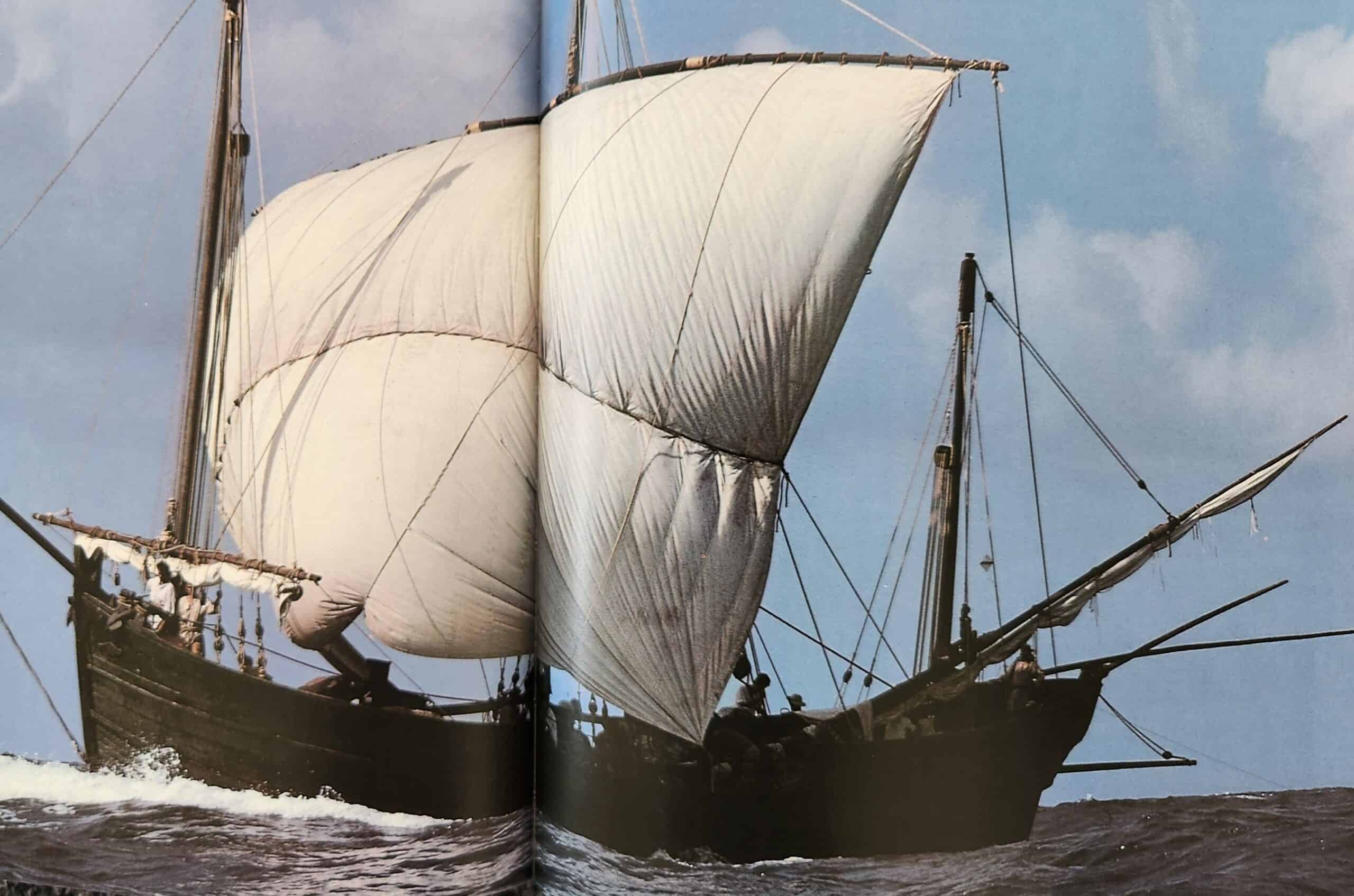
In 1317, a sea captain named Emanuele Pessagno left the Italian port city of Genoa and went to Portugal. From there, he established new trade routes in the Atlantic Ocean using the Portuguese name of Manuel Pessanha. Giovanni Caboto also left Genoa. He changed his name to John Cabot and explored the Atlantic for England. In 1497, John Cabot landed in Newfoundland and other parts of Canada while looking for a sea route to China.
Giovanni da Verrazano left Florence Italy and went to France. From there he sailed across the Atlantic Ocean seeking a passage to China. In 1521, he sailed by Sandy Hook, New Jersey.
Columbus left Genoa to sail the Atlantic for Portugal in 1476. After ten years he left to sail for Spain. In 1492, he crossed the Atlantic hoping to reach China. He reached America instead. Later Spanish explorers found sea routes to China. They also found gold, silver, and other riches in Mexico and South America. Spain quickly became the richest and most powerful nation in Europe.
173 words
7. WARS OF RELIGION IN EUROPE. CATHOLIC SPAIN FAILS TO CONQUER PROTESTANT ENGLAND.
In 1519, the leaders of Austria, Holland, and most of Germany and Italy chose the King of Spain to also rule their Holy Roman Empire.
This increased Spain’s power and influence even more. However, it also put Spain in the middle of deadly and destructive “Wars of Religion” between Catholics and Protestants.
Catholics were Christians who wanted the Pope in Rome to run their churches as he had done for centuries. They wanted the Pope to appoint their priests and determine Christian doctrines and worship services..
In 1517, a German priest named Martin Luther proposed different ideas. Luther claimed that every Christian could understand God’s laws by reading the Bible. His slogan was “Every Christian a priest”. Christians who agreed were called Protestants. They wanted local officials or congregations to choose their priests and run their churches.
Spain helped Catholics suppress and persecute Protestants all over Europe. By the 1530s, King Henry VIII, like most Christians in England, were Protestants. They supported and defended Protestants in Holland and elsewhere.
In 1588, Spain sent an “Armada” to invade England and make it Catholic again. It was a massive force of 137 ships, 10,000 sailors, 52,000 soldiers, and 2,500 cannons.
A small English navy, together with bad weather destroyed that Spanish Armada. However, the English were afraid of future invasions. They did everything they could to get their own colonies in America and trade routes to China. They thought this would make England as rich and powerful as Spain.
247 words
8. ENGLAND INVESTS IN COLONIES AND TRADE ROUTES TO OVERTAKE SPAIN.
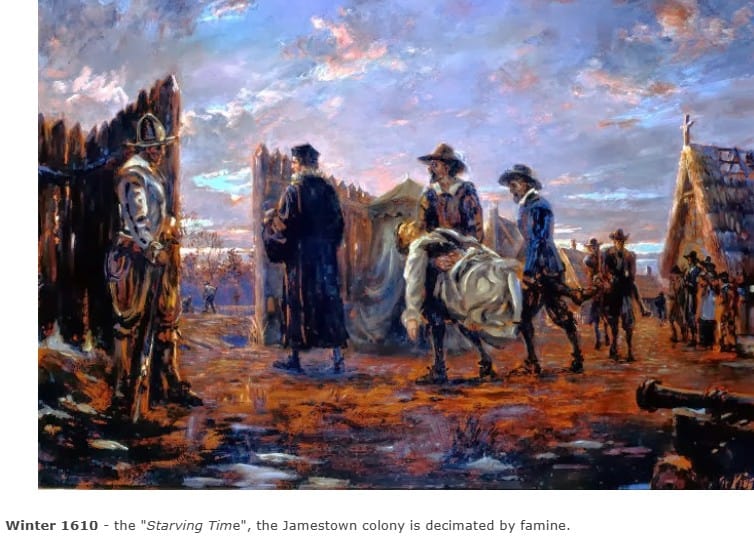
In 1606, the English government chartered private companies to give England trade routes to China and colonies in America. Their investors paid for the needed ships, men and supplies. They hoped to make large profits when their companies succeeded.
Between 1607 and 1610, one English company sent Henry Hudson on three trips to find a sea route to China. He explored the entire North American coastline from the Outer Banks of North Carolina to Hudson Bay in Canada. Hudson sailed by Cape May, New Jersey. However, Hudson failed to find a sea route to China.
In 1607, The Virginia Company of London started a colony in Jamestown. Its first settlers spent much of their time searching for gold. They did not find any. They also failed to grow enough food. Most of them died from hunger during the winter of 1609-1610. That winter was known as “The Starving Time”.
149 Words
9. LAND AND LIBERTY BRING SUCCESS TO ENGLAND’S JAMESTOWN COLONY.
The Virginia Company of London made many changes after The Starving Time.
First, it gave its settlers their own land. Until then, the Company owned almost all land in the colony. Almost everyone who worked it was either an employee or an indentured servant. Indentured servants were people who sold their freedom for seven years to pay off their debts. During this time, they worked like slaves for only food, clothing and shelter.
During this time, all crops that were harvested were put into the company storehouse. There was no connection between what a settler produced and what he or she received.
In 1613, the Company gave a 3-acre plot of land to each family and enough time off to work it. In 1616, the Company gave each family 50 acres. In 1618, it gave 100 acres.
In 1619, the Company also changed its charter to let Jamestown settlers manage their colony. Until then, all decisions were made by Company officers 4,000 miles away in London,
Starting in 1619, all landowners elected representatives to a 22-member House of Burgesses. These representatives made all laws and approved all taxes for the colony.
This enormously increased food production. Men, women and children worked long hours during the growing season to raise, care for and harvest their crops. They were now working for themselves.
The Jamestown settlers now produced much more food than they needed. They traded or sold it for other goods. They also grew tobacco to sell for cash. The Jamestown settlers were soon prosperous and self-sufficient.
This was also good for the Company. Its land became far more valuable. Liberty brought prosperity to everyone.
However, a tragic event also happened in Jamestown that year. At that time Holland was at war against Spain and Portugal. In 1619, a Dutch warship attacked a Spanish slave ship sailing from Africa to Mexico. The Dutch captured roughly 60 Black slaves who were on board. On its way back to Holland, that ship stopped at Jamestown to buy food. It traded roughly 20 of the Black slaves it had captured for the food it needed. Those slaves were treated as indentured servants and set free after seven years. However, other ships later brought more captured Blacks to Jamestown and sold them as slaves. In 1661, the House of Burgesses allowed Black slaves to be legally owned, bought and sold. It also made slave owners the owners of all children born to their slaves.
272 words
Source: How Colonists Acquired Title to Land in Virginia
10. LAND, LIBERTY AND RELIGIOUS FREEDOM BRING PROSPERITY TO MASSACHUSETTS.

In 1620, a new Virginia Company of Plymouth was formed. It got a charter from the English government to set up a second colony in North America. To attract settlers, if offered religious freedom as well as land and self-government.
In 1534, British King Henry VIII and Parliament took control of all Catholic churches in England. They established the Church of England to run them as Protestant churches. The King and Parliament appointed, paid and supervised all priests instead of the Pope.
During the early 1600s, worshippers in the country village of Scrooby were unhappy with how the King and Parliament were running their church. They chose their own priests and conducted their own services.
They were called “Separatists” or Puritans”. They were often harassed and arrested for opposing the government. At first, they fled to Holland. Later, they got permission to settle in a new colony in America being “planted” by The Virginia Company of Plymouth. They left on a ship named the Mayflower in 1620.
Severe storms took them to Massachusetts, far north of the Company’s territory. They decided to settle there instead. Since they had no Company charter to run their colony, wrote an agreement on how to do it themselves. They called it The Mayflower Compact. Those settlers became known as The Pilgrims.
They found abandoned fields that were ready for planting. Later, they learned that a tribe of American Indians had lived nearby. However, these Native Americans had died of a terrible plague a few years before. A survivor named Squanto befriended the Pilgrims. He taught them how to grow native crops like corn, beans and squash.
However, the Pilgrims failed to grow enough food during their first two years. As in Jamestown, none of the settlers owned their own land. All crops were put in a common storehouse and distributed equally.
During the third year, the Pilgrims gave each family its own plot of land. As in Jamestown, families worked much longer and harder on their own land. The Pilgrims then had “bounteous” harvests. They quickly became prosperous and self-sufficient.
In 1632, England created the colony of Maryland as a refuge for Catholics. In 1636 and 1643 new colonies of Connecticut and Rhode Island were established to provide freedom for Christians in Massachusetts who were being persecuted by the Puritan majority!
386words.
11. SLAVERY BROUGHT POVERTY AND VIOLENCE TO AMERICA — NOT WEALTH.
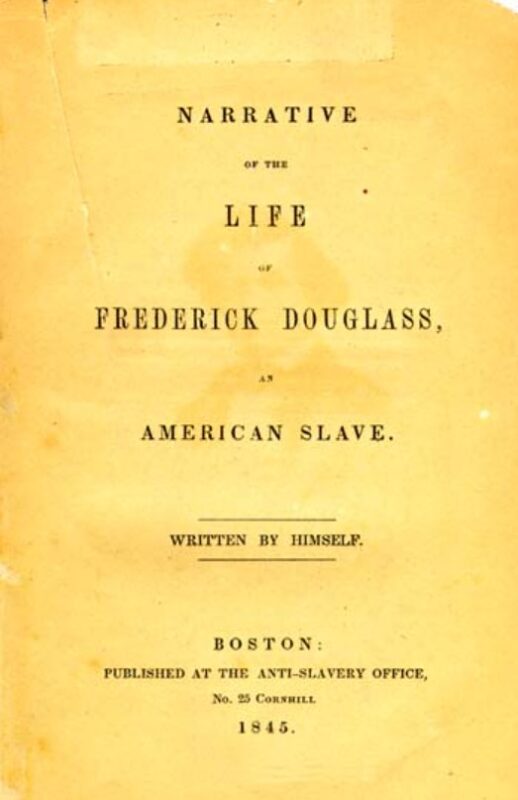
In 2019, the New York Times Magazine published a series of articles and teaching materials about slavery in America called the 1619 Project. Those materials suggest that the enslavement of Blacks in Virginia and other southern states was the source of all wealth and success in America. Was it? Almost everyone who visited slave and free states before the Civil War ended slavery wrote that the opposite was true. Slavery brought poverty and violence wherever it existed in America.
One of the most famous writers on this subject was Frederick Douglass. Douglass was born as a slave in Maryland and lived as a slave until he was 20 years old. Then he escaped and fled to Massachusetts. In his autobiography, Douglass wrote that he was surprised by the abundance and wealth of whites and nonwhites alike in free Massachusetts compared to the widespread poverty in the slave state of Maryland.
Source: *From Narrative of the Life of Frederick Douglass by Frederick Douglass (1845) The Project Gutenberg eBook of Narrative of the Life of Frederick Douglass, by Frederick Douglass
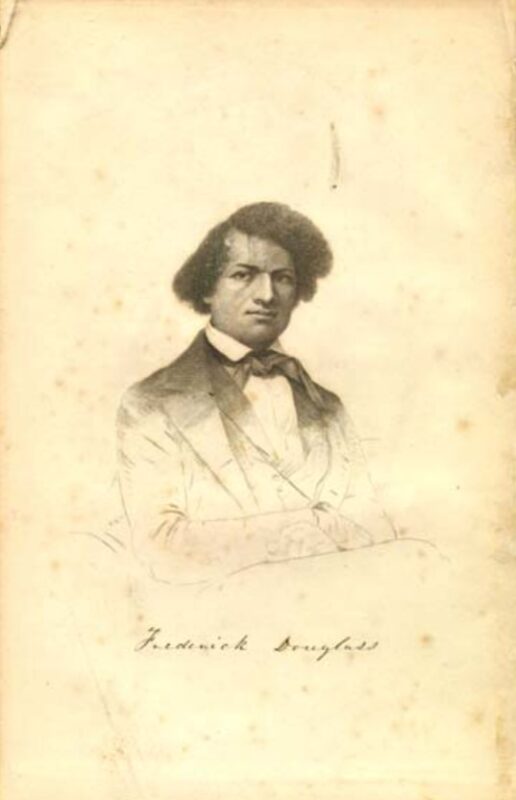
According to Douglass:
“I was quite disappointed at the general appearance of things in New Bedford (Massachusetts). The impression which I had received respecting the character and condition of the people of the north, I found to be singularly erroneous. I had very strangely supposed, while in slavery, that few of the comforts, and scarcely any of the luxuries, of life were enjoyed at the north, compared with what were enjoyed by the slaveholders of the south. I probably came to this conclusion from the fact that northern people owned no slaves. I supposed that they were about upon a level with the non-slaveholding population of the south. I knew they were exceedingly poor, and I had been accustomed to regard their poverty as the necessary consequence of their being non-slaveholders. I had somehow imbibed the opinion that, in the absence of slaves, there could be no wealth, and very little refinement. And upon coming to the north, I expected to meet with a rough, hard-handed, and uncultivated population, living in the most Spartan-like simplicity, knowing nothing of the ease, luxury, pomp, and grandeur of southern slaveholders. Such being my conjectures, any one acquainted with the appearance of New Bedford may very readily infer how palpably I must have seen my mistake.
“In the afternoon of the day when I reached New Bedford, I visited the wharves, to take a view of the shipping. Here I found myself surrounded with the strongest proofs of wealth. Lying at the wharves, and riding in the stream, I saw many ships of the finest model, in the best order, and of the largest size. Upon the right and left, I was walled in by granite warehouses of the widest dimensions, stowed to their utmost capacity with the necessaries and comforts of life. Added to this, almost every body seemed to be at work, but noiselessly so, compared with what I had been accustomed to in Baltimore.
There were no loud songs heard from those engaged in loading and unloading ships. I heard no deep oaths or horrid curses on the laborer. I saw no whipping of men; but all seemed to go smoothly on. Every man appeared to understand his work, and went at it with a sober, yet cheerful earnestness, which betokened the deep interest which he felt in what he was doing, as well as a sense of his own dignity as a man. To me this looked exceedingly strange. From the wharves I strolled around and over the town, gazing with wonder and admiration at the splendid churches, beautiful dwellings, and finely-cultivated gardens; evincing an amount of wealth, comfort, taste, and refinement, such as I had never seen in any part of slaveholding Maryland.
“Everything looked clean, new, and beautiful. I saw few or no dilapidated houses, with poverty-stricken inmates; no half-naked children and barefooted women, such as I had been accustomed to see in Hillsborough, Easton, St. Michael’s, and Baltimore. The people looked more able, stronger, healthier, and happier, than those of Maryland. I was for once made glad by a view of extreme wealth, without being saddened by seeing extreme poverty. “
12. HOLLAND “PLANTS” COLONIES ON BOTH SIDES OF NEW JERSEY WHILE ENGLAND IS WEAK FROM CIVIL WAR.

During the Religious Wars of the 1500s, Protestants in England and the Netherlands (Holland) fought together against Catholic Spain. During the 1600s, they fought each other over trade routes and colonies.
Between 1642 and 1660, England was weak and divided. In 1642, King Charles I tried to arrest members of the elected Parliament who tried to limit his power. Parliament, led by Oliver Cromwell, raised and trained its own “New Model Army” of ordinary citizens to fight back. In 1649, that army defeated the professional soldiers called “Cavaliers” who fought for the King. Parliament captured King Charles I and beheaded him for treason. His sons Charles II and James escaped to France and fought back from exile.
While England was weak, the Dutch established new colonies in North America. They settled New Amsterdam in Manhattan in 1624 and Bergen across the Hudson River in 1660. In 1655, the Dutch took over Swedesboro and other Swedish settlements along the Delaware River.
In 1660, the English ended their Civil War. A new Parliament invited Charles II back from exile and made him King. His younger brother James, the Duke of York, became Lord Admiral of the British Navy.
In 1664, James quickly seized all of the Dutch colonies in America with four British warships and 300 soldiers.
215 Words
13: 1664 ENGLISH CHARTERS GUARANTEE LAND, RELIGIOUS FREEDOM AND SELF-GOVERNMENT IN NEW JERSEY.
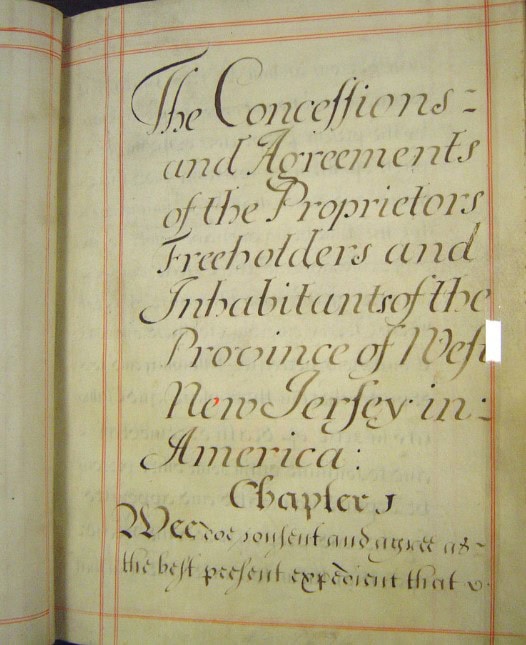
After driving the Dutch out of North America, James, the brother of King Charles II, established two new colonies between the Hudson and Delaware Rivers. He named them after the Isle of Jersey in the English Channel. During the English Civil War, Jersey was an important stronghold, sanctuary, and symbol of defiance for supporters of the King.
James set up East Jersey around Perth Amboy by the Hudson River. He set up West Jersey around Burlington on the Delaware. He gave both colonies similar charters called the ”Concessions and Agreements of 1664”. They offered settlers land, self-government, and religious freedom.
The Jersey charters guaranteed each settler “the freedoms and immunities” of the “the laws and customs of England”. They included freedom to peacefully build and run their own churches and express religious opinions.
Men who came in the first year with “a good musket”, bullets, powder and “six months provision” got 150 acres. Others were given 30 to 100 acres. Landowners then were also called “freeholders”.
All freeholders could vote, hold public office, and elect representatives to an Assembly. The Assembly had the power to “make all such laws, acts, and constitutions as shall be necessary for the well government of the Province”.
The Assembly set up county governments run by “Chosen Freeholders” who were also elected. They built and maintained roads, bridges and courthouses.
Finally, the Concessions and Agreements of 1664 gave the elected Assembly the power to “lay equal taxes and assessments… for the defraying all necessary charges of the Government”.
Years later, most people in New Jersey agreed that the British Parliament could not tax them unless their representatives in the Assembly agreed.
In 1703, the two Jerseys merged into one colony of New Jersey.
288 words
14. QUAKERS BUY LAND FROM LENNI-LENAPI AND SETTLE IN SOUTH JERSEY.
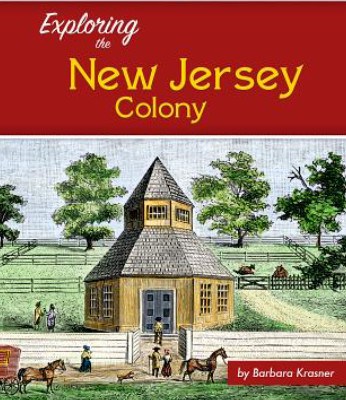
Above Image: Quaker Meeting House in Burlington, NJ Completed In 1687.
The first settlers to West Jersey (now the southern half of New Jersey) were mostly Quakers. Hundreds settled in Salem in 1675. Hundreds more came to Burlington in 1677.
Many Lenni-Lenape lived in villages in and around Burlington. The Quakers appointed “commissioners” to make sure that all land sold to Quakers by Native Americans was sold voluntarily for a fair price.
In 1681, King Charles II gave William Penn land and a charter to establish a colony for Quakers on the other side of the Delaware River. One year later, William Penn began building a new city there. Penn named that city “Philadelphia” after the ancient Greek words for “brotherly love”. He named his colony “Pennsylvania”, Latin for “Penn’s Land of Forests”.
Quakers were members of a Christian movement called “The Religious Society of Friends”. It began in England during the 1650s. Their detractors called them “Quakers” for appearing to be emotional and animated at prayer meetings.
Quakers were Protestants. However, they rejected the leadership and certain practices of the Church of England and other Protestant denominations.
Quakers opposed war and slavery. They gave non-traditional and leadership roles to women. They were skillful, energetic, and successful in almost every business, trade and profession. On average, they were wealthier than members of most other communities.
For all these reasons, Quakers were often persecuted, ridiculed and barred from public office. Some were arrested, imprisoned and even executed in both England and America.
237 words
Mission work and Quaker settlement in colonial New Jersey
New Jersey Natives: The Lenni-Lenape – SouthJersey.com
History | Borough of Magnolia NJ
15. JOHN TOWNSEND LEAVES LONG ISLAND TO HUNT WHALES NEAR CAPE MAY.
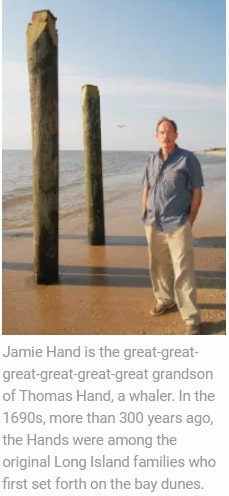
John Townsend was born in Oyster Bay in Long Island, when it was part of the Dutch colony of New Amsterdam. It is not certain whether or not he and his family were Quakers. However, in 1657, members of his family actively defended Quakers who were being persecuted by Peter Stuyvesant, the Dutch Governor. They signed the “Flushing Remonstrance”. It was a petition to Dutch authorities demanding freedom of religion for all Christians including Quakers, and for all non-Christians as well. The Dutch responded by threatening, banishing, and arresting Quakers and those who signed that petition.
John Townsend left Long Island. He settled in Town Bank near Cape May during the 1690s. He hunted whales which were then plentiful in Delaware Bay. He made large profits processing products from whale oil and bone and selling them all over the world.
139 words
john townsend whales long island new york quaker cape may – Search
Endangered New Jersey: Whaling in Historic New Jersey
History of Townsends Inlet ⋆ Southern Sea Isle ⋆ The Shore Blog
John Townsend (1658 – 1721) – Genealogy
Historic Town Bank, New Jersey: A Timeline – Cape May Magazine
Whalers: The Link to our Past – High Tide
16. JOHN SOMERS BUILDS A FARM AND RUNS A FERRY IN SOMERS POINT.

During the 1690s, a Quaker named John Somers bought land in what is now Somers Point. Besides clearing and farming his land, he operated a ferry boat that brought people and goods back and forth across the Egg Harbor River. It connected the Stage Coach Road to New York with the Stage Coach Road to Cape May.
His son, also named John, built the brick house that still stands on the hill near the bridge to Ocean City. It was built between 1703 and 1725. It is a modest house. It has a small kitchen, dining and living area on the first floor, a master bedroom on the second floor, and loft on the third floor where the children slept. However, it was known for years as “The Somers Mansion”.
A nephew, James Somers cleared land and built a farm in what is now Linwood. He also built a dam across the Patcong Creek. Central Avenue runs above the new dam that stands there today.
That dam created Bargaintown Pond. Water running over that dam turned the wheels of two mills. A grist mill was used to grind corn and wheat into flour. A sawmill cut logs into lumber.
For years, ice was harvested from that pond during the winter and used to preserve food during the summer. Part of today’s suburban town of Northfield was then known as the “North Field” of the James Somers farm.
Other Quakers who also established farms and businesses in the area included families named Conover, Leeds, Risley, Scull, Smith, and Steelman.
237 words
17. JERSEY SETTLERS EXTRACT IRON, CUT TREES AND MAKE THEIR OWN SHIPS.
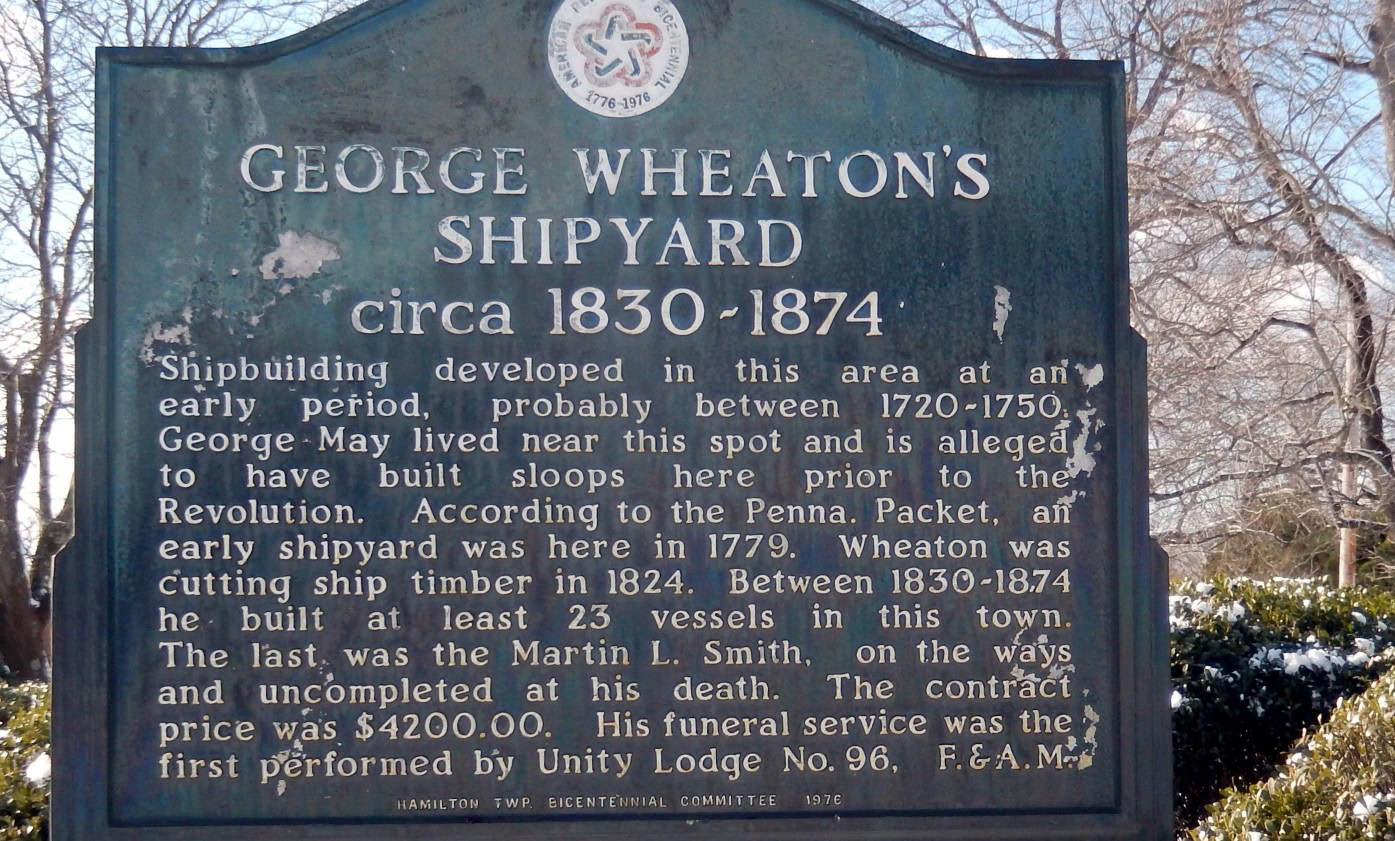
During the early 1700s, blacksmiths found clay and bog iron in and around the marshes and back bays of what are now Atlantic and Burlington Counties in New Jersey. They used the clay to make bricks. They used the bricks to build forges and furnaces to extract the bog iron. They used that iron make their own horseshoes, nails, tools and wrought iron rails. In 1766, they built a large iron forge in Batsto.
By the late 1700s, skilled carpenters were designing ships and using local lumber, nails and tools to build them. George May and Christopher Rape began building ships along the Egg Harbor in and around Mays Landing during the 1780s. At that time, the Van Sant family built ships along the Mullica River in what is now Galloway Township.
132 words
18. NEW JERSEY SETTLERS SET UP SMALL , FRUGAL AND EFFICIENT GOVERNMENTS.
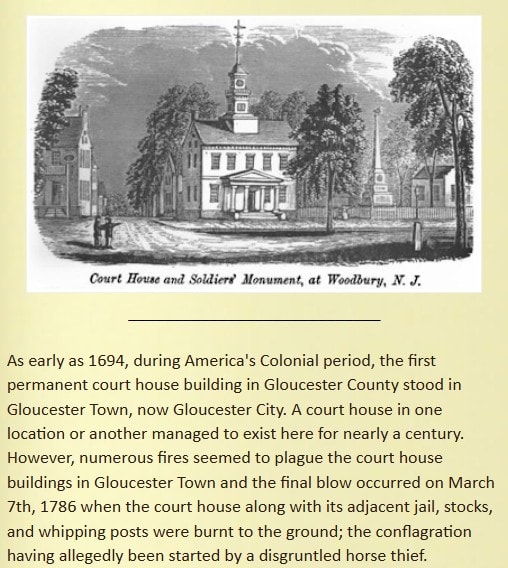
Above Image: All of Atlantic County was part of Gloucester County until 1837.
The first settlers of New Jersey established very small and frugal governments to run their settlements. They had very few laws, rules, officials, and taxes.
In 1670, the colonial government of New Jersey taxed each owner of real estate one half penny per acre each year.
Between 1683 and 1694, New Jersey was divided into nine counties. At that time, Atlantic County was part of Gloucester County.
Most of these counties had four paid officials: They were a county clerk, a judge, a sheriff and a surrogate. The clerk kept a public record of every deed so that everyone would know who owned each parcel of land. The judge decided criminal cases and civil disputes. He presided over jury trials. The sheriff enforced laws and judgments. He had the power to summon citizens to serve on juries and to help him enforce the law as his “posse comitatus” (power of the community). The surrogate protected the rights of widows, orphans and others entitled to the property of those who died. These officials were elected to their positions. They were paid with fees they charged people who used their services.
Each county also elected a Board of Chosen Freeholders (Landowners). They had the power to determine and collect taxes on tax real estate to pay for roads, bridges, jails, courthouses and other things needed by county government.
226 words
19. COLONIAL AMERICA BECOMES THE LEAST TAXED COUNTRY IN RECORDED HISTORY.
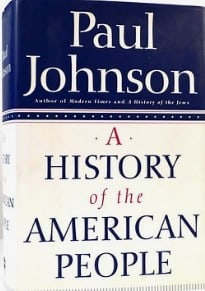
British Historian Paul Johnson, wrote this description of g the British colonies in North America during the 1700s:
“They were the least taxed territories on earth. Indeed, it is probably true to say that colonial America was the least taxed country in recorded history.
“Government was extremely small, limited in its powers, and cheap. Often, it could be paid for from court fines, revenue from loan offices, or sale of lands. New Jersey and Pennsylvania governments collected no statutory taxes at all for several decades.
“One reason why American living standards were so high was that people could dispose of virtually all their income. . . It was the closest the world has ever come to a no-tax society. . .
“By the 1750s, America was unquestionably a success story. It was to a large extent self-governing. It was doubling its population every generation. It was already a rich country and growing richer. Most men and women who lived there enjoyed, by European standards, middle-class incomes once the frugality and struggles of their youth were over.
“The opportunities for the skilled, the enterprising, the energetic, and the commercially imaginative were limitless. . .
“Philadelphia had been founded and shaped by Quakers. But the Quakers themselves had become rich. A tax-list of 1769 shows that they were only one in seven of the town’s inhabitants, but that they made up half of those who paid over L100 in taxes. Of the town’s seventeen richest men, twelve were Quakers.
“Wherever the hard-working, intelligent Quakers sent, they bred material prosperity which raised up others as well as themselves”.
A History of the American People, Paul Johnson, Harper Collins Publishers, New York (1997) Pages 108-109
284 words
20. BRITAIN WANTS AMERICANS TO HELP PAY FOR ITS SEVEN YEARS WAR.

Between 1756 and 1763, the British Empire fought the Seven Years War against many countries around the world. That war was called The French And Indian War in North America. That was because here, Britain and its colonies fought France and its Native American allies.
During that war, many British soldiers and government officials traveled to North America for the first time. They were surprised and jealous when they saw how prosperous, proud and self-reliant most Americans had become. One of them wrote the song “Yankee Doodle” to mock those Americans.
The English paid for that war with very high taxes. Many resented Americans for not paying their share.
After the war, the British Parliament imposed new taxes on Americans without the approval of their colonial assemblies. It also enforced old laws to stop Americans from trading with other countries.
In 1773, the British imposed a new tax on tea imported from India. It also allowed one company, the British East India Company, to reduce its prices by bringing its tea directly from India to America. American ships could not do this. English laws required them to pay extra to first bringing goods from other countries to English ports.
Many Americans were afraid that if taxes and preferential treatment like this became normal, they would lose liberty and prosperity they had gotten used to.
On December 16, 1773, Americans in Boston dumped tea from three British East India Company ships into the water. That tea was worth roughly $1.7 million in today’s dollars. There were similar protests in Philadelphia, New York, Annapolis and Charleston.
During the fall of 1774, a British East India Company ship tried to avoid those cities. It quietly unloaded its tea in the small village of Greenwich in Cumberland County, New Jersey.
However, the New Jersey farmers discovered, removed, and burned the tea. Today, locals pronounce the name of their town as “Green Witch”. In New York, Connecticut and England, towns spelled the same way are pronounced “Grennitch”. It is widely believed that residents of the New Jersey Greenwich did that to show they wanted nothing to do with the English Greenwich.
356 words
21. RICHARD STOCKTON SIGNS DECLARATION OF INDEPENDENCE. THEN LOSES EVERYTHING.
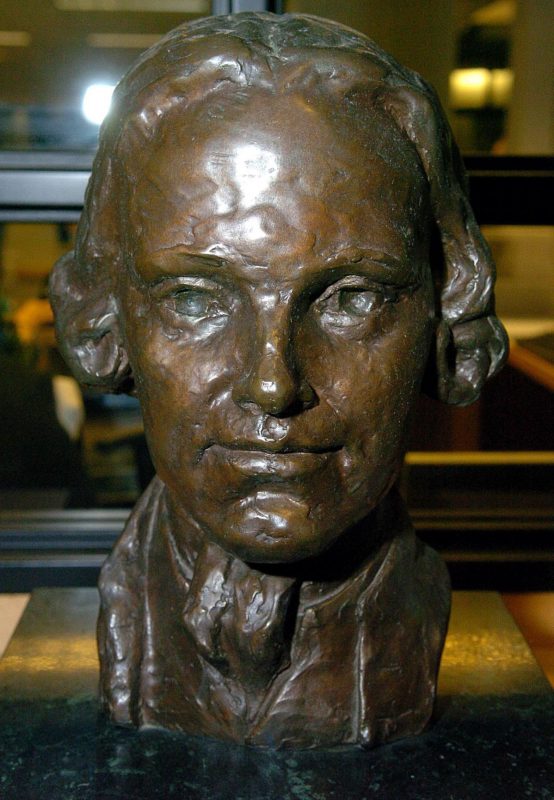
Richard Stockton was born in 1730 in Princeton, New Jersey. His parents were Quakers. Like many Quakers, they had become rich by building and expanding large and productive farms there. Stockton increased that wealth by efficiently managing his family’s properties. He took a special interest in breeding choice cattle, horses, hogs and sheep. At age 24, Stockton became a lawyer and active trustee in what is now Princeton University. He also collected art and literature.
Stockton and his family could have lived comfortably with the new laws and taxes imposed by the British after 1763. However, like the citizens of Boston and farmers of Greenwich, Stockton was afraid America would lose its exceptional liberty and prosperity.
In 1766, 36-year-old Richard Stockton traveled throughout Britain. There he explained America’s point of view to King George III and Britain’s top leaders.
After the Boston Tea Party of 1774, Stockton tried to negotiate a settlement with Britain. When he failed, he represented New Jersey in the Second Continental Congress in Philadelphia. On July 2, 1776, Stockton was one of the 56 men who signed the Declaration of Independence. That September, Congress sent him to Fort Ticonderoga in to upstate New York to prepare for a British invasion from Canada.
That November, Stockton was captured by local Tories (Americans loyal to Britain) while returning home. He was put in a cold, crowded and filthy prison cell and given “meager” rations. He was released on parole after George Washington personally protested his treatment.
While he was away, the British had ransacked and plundered Stockton’s home and farms. They destroyed or took away all of his furniture, clothing, books, papers and pictures. His prized horses, cattle, hogs and sheep were killed, taken, or driven off.
Stockton struggled to regain his health and rebuild his life. In 1778, he developed cancer in his lip which spread in spite of extensive surgery. Stockton suffered constant pain until he died in 1781 at age 50.
326 words
22. RICHARD STOCKTON OWNED AT LEAST ONE SLAVE. WAS HE ANY LESS OF A HERO?
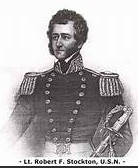
Stockton University is named after Richard Stockton. It is an undergraduate and graduate university owned and operated by the State of New Jersey. Its main campuses are in Galloway Township and Atlantic City.
In 1978, a bust of Richard Stockton was displayed at the main entrance of the university’s library. However, during the Black Lives Matter riots of 2017, it was moved to a little used reading room. This was because Richard Stockton was said to a slaveowner. Does that make him unworthy of recognition and praise?
Richard Stockton was the legal owner of at least one Black slave. His name was Marcus Marsh. Marsh was born on Richard Stockton’s farm in 1765. His mother died when Marsh was an infant. Marsh then lived with Richard Stockton and his wife until he was 16 years old when he was set free.
Richard Stockton and his wife raised Marcus Marsh in their home with their six children. They were all given the same food, clothing, and education. When Stockton’s daughter Julia married Dr. Benjamin Rush, George Washington’s personal physician, Marsh studied medicine with him. Marsh then became an apothecary. An apothecary was a pharmacist who compounded medicine and also treated patients.
We do not know if Richard Stockton owned other slaves. If he did, we do not know if they were treated like Marcus Marsh. All of Richard Stockton’s papers were destroyed or stolen when the British ransacked his home in 1776.
We do know that Richard Stockton and his family opposed slavery as did most Quakers in New Jersey and Pennsylvania. Many bought slaves for the purpose of freeing them. Others bought them on the same terms as white indentured servants who were freed after seven years. Often Blacks who were legally owned by Quakers were safer than freed Blacks who could be falsely accused of being runaways.
In 1821, Robert Stockton, the grandson of Richard Stockton commanded a warship of the U.S. Navy. After the United States and most European nations made it illegal to bring slaves out of Africa, Robert Stockton captured slave ships and freed their slaves. During the 1846 War With Mexico, Robert Stockton sent naval forces inland into California to keep slavery out of that territory.
371 words.
Richard Stockton (Continental Congressman) – Wikipedia
23. “LIBERTY AND PROSPERITY” BECOMES THE MOTTO OF NEW JERSEY
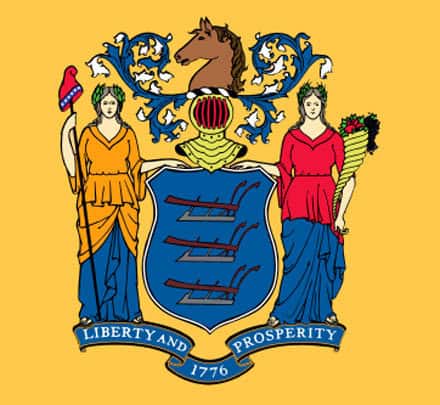
On July 2, 1776, New Jersey declared itself to be an independent state and adopted a new state constitution. On month later, the legislature agreed on a new seal and flag for the state. The main images on that seal and flag were two ancient Roman goddesses standing side by side.
The goddess on the left is Libertas, the goddess of liberty and freedom. The goddess on the right is either Ceres, the goddess of bountiful harvests or Abundantia, the goddess of abundance and prosperity,
Libertas, the goddess of liberty is associated with two symbols, a red cap often known as a Liberty Cap or Phrygian Cap. According to legend, that cap was worn by freed slaves in ancient Rome. At that time, a slave was often identified by a shaved head or the name or symbol of the owner tattooed on it. Wearing a Liberty Cap announced that a former slave was now a free man.
In ancient Rome, Libertas was also associated with either a spear or a wooded stick or pike. The spear could have reminded Romans that freedom must constantly be defended. It could have reminded them that many slaves won their freedom when they fought in the army to defend the Republic. The wooden stick or pike could have reminded people of the rod (vindicta) used by a magistrate at the ceremony declaring that a slave was legally free. However, it may also depict the wooden pike commonly used as a weapon in England and Ireland during the English Civil War of 1641 to 1652.
That pike was the weapon of common citizens. It was cheap and easy to make. It required little training. It was useless in the hands of one man fighting alone against an aristocratic knight on a horse with a lance and sword. However large groups of common men fighting together with simple wooden pikes could knock privileged knights off their high horses to preserve their freedom.
Standing next to liberty on the New Jersey flag and seal is a goddess carrying a cornucopia or horn of plenty. In ancient Rome, the goddesses of Ceres and Abundantia were associated with the cornucopia. That figure on the New Jersey state seal and flag symbolizes prosperity.
The New Jersey state flag reminds us that Liberty and Prosperity appear together.
24. GEORGE WASHINGTON’S ARMY RETREATS: “THE CONDUCT OF THE JERSEYS HAS BEEN MOST INFAMOUS!”
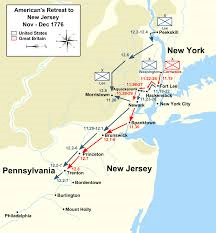
On July 4, 1776, the Declaration of Independence was published in Philadelphia. One month later, a massive British fleet of 300 ships, 10,000 sailors, and 30,000 soldiers arrived in New York Harbor. Some 18,000 of them were Hessians – professional soldiers hired Britain from Hesse and other states in Germany.
That August and September, the British and Hessian soldiers attacked and defeated George Washington’s army of 28,000 men in Brooklyn, Manhattan, and White Plains, New York.
Washington crossed the Hudson River and retreated to Hackensack, New Jersey with fewer than 3,000 men. He hoped that thousands of men from New Jersey militias would rally to support him. They did not.
In a letter to his brother, Washington wrote: “The conduct of the Jerseys, has been most Infamous—Instead of turning out to defend their Country and affording aid to our Army they are making their Submissions as fast as they can”.
Washington and his men retreated to Bucks County, Pennsylvania. Most members of the Continental Congress left Philadelphia and moved to Baltimore. Many Americans believed that their war for independence from England had been lost.
However, George Washington got encouragement from an unlikely source. Quakers in South Jersey.
197 words
Washington’s Retreat Through New Jersey, 1776, Events, Outcome
Battle of Long Island (Aug. 27, 1776) Summary & Facts
The Stony Brook Quakers and the Battle of Princeton Historical Marker
25. “FIGHTING QUAKERS” FROM SOUTH JERSEY HELP SAVE GEORGE WASHINGTON’S ARMY.
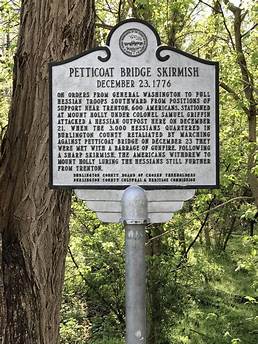
Since the 1650s, most Quakers in England and America were known as pacifists. This “Peace Testimony” was part of their core values:
“We utterly deny all outward wars and strife and fightings with outward weapons, for any end, or under any pretence whatsoever.”
However, many younger Quakers believed in self-defense. They thought Americans had a right to defend their independence from Britain. They were also outraged when British and Hessian soldiers looted farms and took over homes, and abused Quakers during their occupation of much of New Jersey during November and December of 1776.
When Washington’s army retreated to Pennsylvania, these “Fighting Quakers” formed militias that attacked British and Hessian soldiers throughout South and Central Jersey. The prevent the British and Hessians from getting needed food and supplies.
in South Jersey. Richard Somers, a tavern owner from Somers Point, led a militia company of 200 men from Galloway and Egg Harbor Townships, then part of Gloucester County. They and 400 men from Haddonfield and Woodbury militias marched to Mount Holly. On December 21, they attacked Hessian troops at Petticoat Bridge in what is now Columbus, New Jersey.
During the time, Thomas Paine published a popular pamphlet called “The American Crisis”. It gave Americans new hope in their cause with these famous words, “These are the times that try men’s souls: The summer soldier and the sunshine patriot will, in this crisis, shrink from the service of his country; but he that stands it now, deserves the love and thanks of man and woman”.
This convinced George Washington that New Jersey was not lost. During the days before Christmas of 1776, he made plans to return and attack the Hessians in Trenton. That Christmas night, Washington and 2,500 soldiers crossed the Delaware River. The following morning, they won an overwhelming victory. They killed or captured roughly one thousand Hessian soldiers. Only two Americans died. One week later, the Americans won a second decisive victory against the main body of British troops at Trenton. The Americans then won a third battle at Princeton.
George Washington did far more than regain control of most of New Jersey. News of these three victories instantly revived support for American independence throughout the world.
368 words
26. BLACKS AND WOMEN IN NEW JERSEY WIN AND LOSE THE RIGHT TO VOTE.
On July 2, 1776, delegates of all 13 British colonies in North America voted to declare their independence from the British Empire. On that same day delegates in New Jersey adopted a new State Constitution.
New Jersey’s first State Constitution allowed men and women of all races to vote. The only requirement was that they be worth “Fifty Pounds of proclamation money. . . and have resided within the County in which they claim a vote for twelve months immediately preceding the election”.
During the 1790s, Thomas Jefferson and other supporters of the French Revolution organized “Republican” Parties throughout America, including New Jersey. (Their “Republican” Parties were “left-wing” parties who claimed to represent the common people. They were completely unrelated to the Republican Party formed by Abraham Lincoln and others in 1854 to oppose slavery. In many ways, their views were closer to those of Andrew Jackson and Martin VanBuren who formed the Democratic Party in 1854). The Thomas Jefferson Republican Parties claimed to be the party of the common people. They opposed numerous policies of President George Washington and Alexander Hamilton, his Secretary of the Treasury who they claimed to be privileged aristocrats.
For example, those Thomas Jefferson Republicans also opposed property requirements for voting.
Those who supported Washington and Hamilton called themselves “Federalists”. They organized their own political parties led by conservatives like John Adams.
During the next 20 years, the Federalists and the Republicans campaigned against each other in every election in New Jersey and throughout the United States. During this time, the winners of each election changed the voting rules to give their side an advantage in the next election.
In 1807, the Republicans defeated the Federalists in New Jersey. They then changed the voting laws to eliminate property requirements. They also barred women and Blacks from voting. They did this because women and Blacks at the time tended to vote for Federalists.
Black Americans did not win the right to vote again in New Jersey until the 14th and 15th Amendments to the U.S. Constitution were adopted after the Civil War in 1868 and 1870. Women could vote again in New Jersey until the 19th Amendment to the U.S. Constitution was adopted in 1920.
356 words
27. RICHARD SOMERS FIGHTS AND DIES BY THE SHORES OF TRIPOLI.

The Somers Point tavern owner who led the Gloucester County militia in 1776 had a son also named Richard Somers.
Young Richard Somers was born in 1778. Like most Americans of his time, Richard Somers completed school at age 15 after eight years of education. However, Somers, like most Americans then, had better reading, writing, and arithmetic skills, and knew more about science, history, and literature than most college graduates today.
Like most Americans then, Somers mastered a useful trade and was supporting himself by age 16. At that age, Somers was the skipper of merchant ships that sailed along the Atlantic Coast.
During that year of 1794, America had no navy. It was disbanded when our War for Independence ended in 1783. Most Americans thought there was no need to waste money on a navy when our country was at peace. They were wrong.
For more than a thousand years, warships from the “Barbary” kingdoms of North Africa attacked and robbed non-Muslim ships and coastal towns as far north as Iceland. They sold the people they captured as slaves. They were not “pirates” and could not be punished as criminals. If captured, they were prisoners of war. That is because the Barbary kingdoms always declared war on the nations they attacked.
For years, sea powers like England, France and Spain fought the Barbary Kingdoms. Later, they found it cheaper to buy protection by paying ransom and tribute. When America was part of the British Empire, our ships were protected by the tribute paid by Britain. When we won independence in 1783, our ships were attacked and seized. Their passengers and crew were sold into slavery.
For years, America also paid tribute. However, in 1798, Americans were attacked by French pirates in the Caribbean who also demanded bribes. Americans refused to pay. We shouted, “Millions for defense. Not one cent for tribute!” America built a new navy. Richard Somers, then 20 years old, was one of the first to join.
In 1801, President Thomas Jefferson sent our navy to North Africa to fight the Barbary Kingdoms. In 1803, Richard Somers was given command of the warship Nautilus with 103 men when he was 24 years old.
The new American navy amazed the world with its success. All but one of the Barbary Kingdoms made peace with us. Only Tripoli continued to fight. On September 4, 1804, Richard Somers and 12 others sailed the Intrepid, a ship packed with explosives, into Tripoli Harbor to destroy the enemy fleet. They were all killed when the ship exploded prematurely.However, one year later, American marines went “to the shores of Tripoli” and ended the war – and America’s payment of tribute. 447 words Remember the Intrepid: Richard Somers – Key Date Illustrated Chronology
28. THE “UNDERGROUND RAILROAD” IN SOUTH JERSEY FREES SLAVES AND DAMAGES SLAVE ECONOMY IN MARYLAND AND DELAWARE.
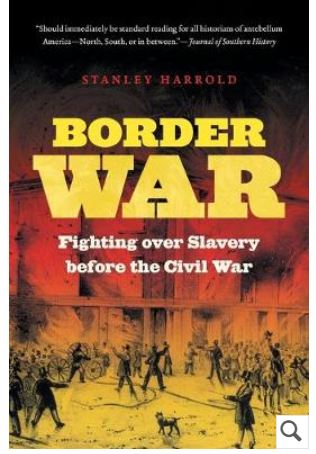
The original U.S. Constitution of 1787 permitted Black Americans to be owned as slaves. However, in his Cooper Union speech of 1860, Abraham Lincoln explained that the Founding Fathers had put slavery “on the path to its ultimate extinction”. They believed that slavery in America was unprofitable as well as unjust and would soon end it on their own.
The Founders were wrong. The cotton gin of 1793 and factories in England that mass-produced cotton fabric quickly made cotton—and slavery—obscenely profitable. Instead of disappearing, slavery grew rapidly in the southern states and territories.
This caused anger in the rest of the country, especially after 1826. That was America’s Jubilee Year, 50 years after the Declaration of Independence. The words on the Liberty Bell in Philadelphia were from a passage in the Old Testament Book of Leviticus. That passage called for all slaves to be set free after 50 years.
In 1829, William Lloyd Garrison in Boston demanded the immediate end to slavery in America. He published in anti-slavery newspaper, The Liberator, in 1831. In 1833, he helped form the American Anti-Slavery Society near the Liberty Bell in Philadelphia. Within five years it had 1,350 local chapters and more than 250,000 members.
Helping slaves escape was the most direct and effective way to end slavery. During the 1830s, healthy adult slaves sold for $500 to $1,000 each. Many slave owners borrowed money and bought insurance for their slaves. Helping slaves escape caused financial losses to banks and insurance companies as well as slave owners. This is explained in detail in the 2010 book Border War by Stanley Harrold.
Opponents of slavery formed an “Underground Railroad”. It was a network of activists who smuggled Black slaves out of slave states in the South. They risked arrest and civil and criminal penalties to take them to safe places in the North or in Canada. Much of this Underground Railroad was in South Jersey.
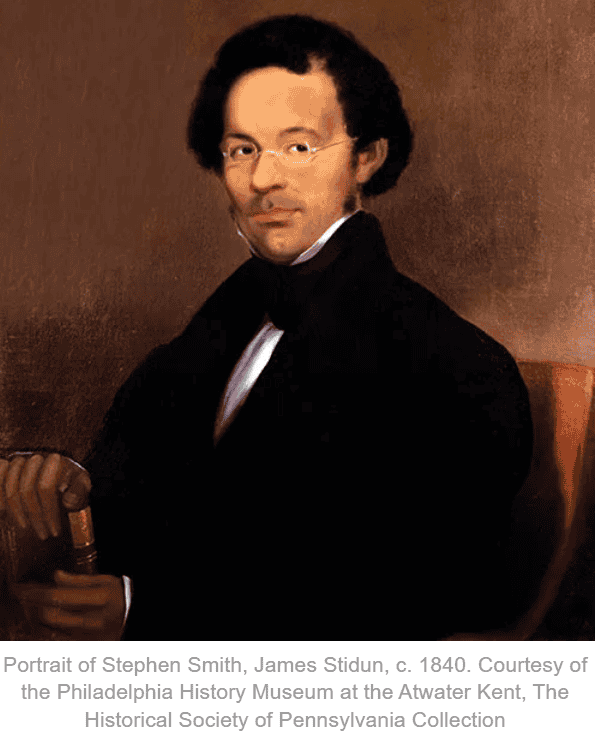
Stephen Smith was born to an enslaved woman in Pennsylvania in 1797 and grew up as an indentured servant. He bought his freedom in 1818 when he was 21 years old. He set up a very successful business shipping coal and lumber to Pittsburgh and Philadelphia. He spent much of his fortune helping slaves escape from Maryland. After Congress passed the Fugitive Slave Act in 1850, he helped thousands of escaped slaves travel to Canada. In 1845, Smith bought a house in Cape May. From there he worked with others to help slaves escape from Delaware.
In 1849, Harriett Tubman escaped from Dorchester, Maryland and came to Philadelphia. She then worked in both Philadelphia and Cape May to lead more than 300 slaves into freedom. Many were rowed across the Delaware Bay to Cape May. They were often hidden in an hold hotel that later became the St. Mary by the Sea Retreat House.
Escaped slaves were also hidden in churches and Quaker meeting houses in Somers Point, Egg Harbor City, Swedesboro, Greenwich and Woodbury.
401 words
how many chapters and members did the american anti-slavery society have in 1838? – Search
29. “SYSTEMIC CORRUPTION” CAUSES 1837 ECONOMIC COLLAPSE. NEW NJ STATE CONSTITUTION BRINGS RECOVDRY.
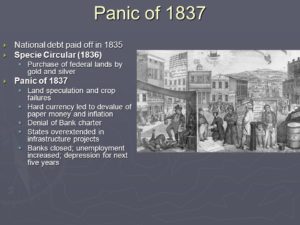
In 1837, America had an economic collapse that lasted seven years. Over 40% of all banks failed. Many people lost their life savings. Businesses closed, prices declined, and there was mass unemployment. Many lost their homes, farms and businesses in foreclosure when they could not make payments on their mortgage loans. There was widespread pessimism
Connecticut, New Jersey, and Delaware reported the greatest stress in their mercantile districts
The biggest cause of this was “systematic corruption” in state and local government throughout America. This caused widespread waste and unsustainable debt that wrecked the economy for more than seven years in most of America.
Professor John J. Wallis of the University of Maryland explained this in his 2006 research paper The Concept of Systematic Corruption in American History.
Systematic corruption is both a concrete form of political behavior and an idea. In polities plagued with systematic corruption,
a group of politicians deliberately create rents by limiting entry into valuable economic activities, through grants of monopoly, restrictive corporate charters, tariffs, quotas, regulations, and the like. These rents bind the interests of the recipients to the politicians who create them. The purpose is to build a coalition that can dominate the government. Manipulating the economy for political ends is systematic corruption. Systematic corruption occurs when politics corrupts economics.
With systematic corruption, politicians cannot win elections without the support of powerful business owners. Businesses cannot succeed with the support of politicians. The result is what Michael Lewis wrote in his book The Big Short, which described the similar 2008 economic collapse:
“What are the odds that people will make smart decisions about money if they don’t need to make smart decisions—if they can get rich making dumb decisions?”
The 1831 dam and waterway of the Trenton Delaware Falls Company. The project was a “public private partnership”. State government formed a private corporation and issued bonds to borrow money to build a dam across the Delaware River. It also paid to build waterways to use water from the lake behind that dam to turn the water-wheels at 19 privately owned factories in Trenton. However, the technology changed quickly. Steam replaced waterpower. The project was obsolete before it was finished. The Trenton Delaware Falls Company failed and did not repay its loans. Banks that bought the state bonds failed. Everyone who saved money at those banks lost their savings.
The same thing happened to canal and other projects over New Jersey. Companies got loans and permits from state government and state-chartered banks because they had political influence. Private investors profited when these projects succeeded. The public lost money when they failed.
In 1844, New Jersey held a State Constitutional Convention to fix this. Dr. Jonathan Pitney represented Atlantic County in that Convention. The delegates quickly agreed on a new State Constitution with these three basic limits on state government power: 1. State government could not borrow money without the approval of voters in n a referendum. 2. State government could not make special laws for special businesses or people. All laws had to apply equally to everyone. 3, State government could not be involved in private business ventures.
According to Professor Wallis:
“The state’s (sic) solution the paradox of corruption and economic development was as simple as it was ingenious. First, states eliminated the pressure to create special corporate privileges by enacted constitutional provisions requiring legislatures to pass general incorporation laws allowing unlimited entry into corporate status via an administrative procedure. Second, states passed constitutional provisions requiring that all state borrowing required a bond referendum: mandating that the higher taxes necessary to service the bonds be approved by the voters before the bonds were issued. Third, most states forbade state and local investment in private corporations. . . “
(PDF) The Concept of Systematic Corruption in American Political and Economic History
These basic provisions of New Jersey’s 1844 state constitution were continued in its new state constitution in 1947. However, since the 1960s, New Jersey’s Supreme Court has approved many state debts without voter approval, and many laws which give special treatment to certain businesses and individuals. The “public-private partnerships” that caused the economic collapse of 1837 are common in New Jersey again today.
LibertyAndProsperity.com is a tax-exempt, non-political education organization of roughly 200 citizens who mostly live near Atlantic City, New Jersey. We formed this group in 2003. We volunteer our time and money to maintain this website. We do our best to post accurate information. However, we admit we make mistakes from time to time. If you see any mistakes or inaccurate, misleading, outdated, or incomplete information in this or any of our posts, please let us know. We will do our best to correct the problem as soon as possible. Please email us at info@libertyandprosperity.com or telephone (609) 927-7333.
If you agree with this post, please share it now on Facebook or Twitter by clicking the “share” icons above and below each post. Please copy and paste a short paragraph as a “teaser” when you re-post.
Also, because Facebook, YouTube and other social media often falsely claim our posts violate their “community standards”, they greatly restrict, “throttle back” or “shadow ban” our posts. Please help us overcome that by sharing our posts wherever you can, as often as you can. Please copy and paste the URL link above or from the Twitter share button to the “comments” section of your favorite sites like Patch.com or PressofAtlanticCity.com. Please also email it to your friends. Open and use an alternate social media site like Gab.com.
Finally, please subscribe to our weekly email updates. Enter your email address, name, city and state in the spaces near the top of our home page at Homepage – Liberty and Prosperity. Then click the red “subscribe” button. Or email me at sethgrossman@libertyandprosperity.com or address below. Thanks.
Seth Grossman, Executive Director
LibertyAndProsperity.com
info@libertyandprosperity.com
(609) 927-7333
